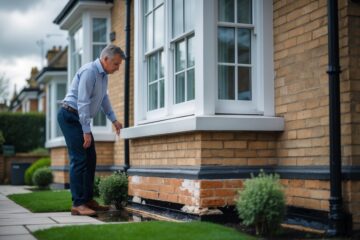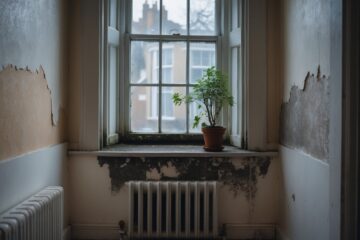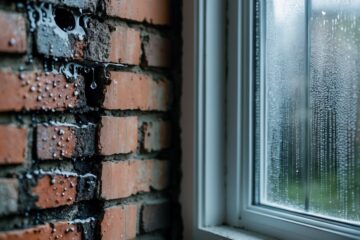Protecting your home from dampness starts with understanding the different types of damp proof courses (DPC). Choosing the right DPC can save you time, money, and a whole lot of headaches down the line.
With the right info, you’ll be able to make a decision that actually keeps your living space dry and comfortable. It’s not rocket science, but it does matter.
Damp issues can sneak up on anyone, leading to ugly mould and even structural headaches. When you know what a damp proof course is—and the options like physical barriers, chemical treatments, or membrane solutions—you can finally tackle moisture intrusion with some confidence.
This guide walks you through the key types of DPCs and helps you figure out which method might actually work for your place.
Whether you live in a charming old house or a brand-new build, dealing with dampness is something you don’t want to ignore. You’ll pick up tips on spotting damp problems and learn how to handle them with the right damp proofing solution.
Key Takeaways
- Different types of damp proof courses work for different properties.
- Spotting damp issues early helps you avoid major damage.
- The right DPC really boosts your home’s protection against moisture.
What Is a Damp Proof Course (DPC)?
A damp proof course (DPC) is a basic but crucial feature in modern homes. It keeps moisture from rising through your walls and protects your living spaces from water damage.
Knowing how a DPC works, the materials involved, and why it matters will help you keep your home healthy.
How a DPC Works
A DPC is basically a barrier you install in the walls, usually about 150mm above ground level. It stops moisture from the ground from creeping up through capillary action, which can mess up plaster, paint, and woodwork.
When moisture gets into walls, you might end up with mould and long-term structural problems. The DPC acts as a shield, blocking this upward movement and keeping your home’s interior dry.
Bitumen and Other Common Materials
Most DPCs use materials like bitumen, plastic sheeting, or even slate. Bitumen is tough and waterproof, so builders like it. Usually, they apply it in strips inside the mortar joints.
Other options include high-density polyethylene or damp proof membranes (DPMs). These choices are all about resisting moisture and protecting your home.
Why DPCs Are Needed in Homes
Damp proof courses protect your home from the nasty effects of moisture. Without a DPC, rising damp can cause wood rot and encourage mould.
Adding a solid DPC doesn’t just keep your home safer—it can make it more attractive to buyers, too. People want homes that feel dry and comfortable, after all.
Types of Damp Proof Courses
There are several types of damp proof courses, and each one fits different needs. Knowing these types helps you make smarter decisions about keeping moisture out of your property.
Physical Damp Proof Courses
Physical DPCs usually use materials like bitumen, plastic, or stainless steel. These barriers go inside the walls, often just above ground level, to stop moisture from creeping up through the masonry.
You’ll often see bitumen DPCs in older homes. They work well, but over time, they can wear out. Plastic DPCs last longer and hold up better against chemicals, so they’re getting more popular. If you want something that’ll last and last, stainless steel DPCs are worth a look.
Chemical Damp Proof Courses
Chemical DPCs (CDPCs) involve injecting a special chemical into the wall. This creates a moisture barrier, which is handy if your property already has signs of rising damp.
The process means drilling holes at intervals and filling them with the chemical, forming a water-repellent layer inside the masonry. It’s less invasive than physical DPCs and usually quicker to get done. Still, results can depend on your wall type and how much moisture is already there.
Electro-Osmotic Damp Proof Course
An electro-osmotic DPC uses a mild electric current to push moisture away from your walls. This method works well for stubborn rising damp that doesn’t respond to other treatments.
By installing electrodes in the wall, you set up a water-repellent barrier. The current moves moisture out of the structure. It might cost a bit more, but it’s a long-term fix that doesn’t change your walls much.
Mortar Injection Damp Proof Course
Mortar injection DPCs mean injecting a thick, waterproof mortar mix right into the walls. This blocks moisture and is a good call for older properties with big damp problems.
The job involves drilling holes in the mortar joints and pumping in the mixture, which hardens and forms a strong barrier. It works on both internal and external walls. Just make sure you let it dry properly—if it doesn’t cure right, you could end up with more damp later.
Physical DPCs: Methods and Materials
Physical DPCs come in a few types, and knowing what’s out there helps you prevent moisture problems. These systems put up a barrier to stop rising damp and protect your home’s structure.
Slate and Stone Layer Systems
Slate and stone layers are some of the oldest options for damp proofing. Builders place these materials horizontally inside the walls, making a barrier against moisture.
- Durability: Slate lasts ages. It doesn’t break down easily, so it keeps working for decades.
- Installation: During construction, slates go between bricks or blocks. You need to place them carefully so there aren’t any gaps where moisture could sneak through.
These systems don’t need much maintenance. If you want something solid and proven, slate or stone could be your best bet.
Bitumen, Polyethene and Plastic DPCs
Bitumen, polyethene, and plastic DPCs are newer options that work really well. Usually, they come as membranes that seal out rising damp.
- Bitumen: This sticky, waterproof stuff sticks to most surfaces and is great in damp areas.
- Polyethene and Plastic: Lightweight, flexible, and they don’t rot. Especially handy for renovations where you might need something that bends a bit.
Using these materials can really cut down on damp-related structural damage. Choosing bitumen or plastic DPC can make things easier and give you solid protection.
Chemical DPCs and Injection Treatments
Chemical DPCs are a solid fix for stopping rising damp in your home. They work by injecting a chemical barrier into the masonry, which helps keep moisture out. Here’s what’s involved.
Standard Chemical DPC Injection
This is a common way to handle damp. You inject a special liquid into holes drilled in your masonry walls. The fluid forms a water-repellent barrier and stops moisture from climbing past the DPC line.
Most of these chemicals are silicon-based, which changes how the masonry absorbs water. The process is quick, and you can usually get it done in a day.
The method doesn’t mess up your walls too much—just a few holes, so not much to look at afterward. After treatment, you’ll want to wait a bit for the DPC to set.
Mortar Injection Process
Mortar injection is another way to create a damp proof course. Here, you insert a modified mortar with damp-proofing chemicals into the wall. The goal is to build a physical barrier that keeps moisture out.
This method is especially good for older buildings where other DPCs might not work. You inject the mortar into pre-drilled holes, filling gaps and making the wall stronger against damp.
Mortar injections can beef up the structure and keep damp at bay. If you’re thinking about this, it’s smart to talk to a pro to see if it’s right for your place.
Membrane and Cavity Solutions
When you’re looking at damp proofing, damp proof membranes and cavity wall DPCs both work well. They’re made to stop water from getting in and keep your home dry. Here’s how they do it.
Damp Proof Membrane Installation
A damp proof membrane (DPM) is a plastic barrier, usually installed below ground level or under floors. It’s tough and keeps water out.
Before you put it in, make sure the surface is clean and smooth so it doesn’t tear. Lay the membrane flat, avoid wrinkles, and overlap seams for extra protection. Use tape to seal any overlaps and keep it watertight.
Sometimes, you’ll need a ventilation system with a DPM to help air move around. Otherwise, trapped moisture can still cause problems.
Cavity Wall DPCs
Cavity wall DPCs are a strong option for homes with cavity walls. They’re made to stop moisture from moving up through the walls.
Builders install these during construction, using waterproof material in the mortar joint. Water runs down into the cavity and drains away, so it doesn’t get inside.
If your house already has cavity walls, you can still add a DPC. Ask a professional about the best way to do it, so your walls stay dry and safe.
Spotting Damp Issues in Your Home
Finding damp problems early can save you from expensive repairs later. Watch for signs like rising damp, mould, and condensation—these can really hurt your home’s structure.
Signs of Rising Damp
Rising damp happens when ground moisture climbs up your walls. Keep an eye out for:
- Tide marks: Look for a discoloured line, usually about a metre up the wall.
- Peeling paint or wallpaper: This can mean moisture is trapped behind the surface.
- Salts or efflorescence: White, powdery stuff on the walls is a classic sign.
- Damp patches: Soft, cold patches are another giveaway.
If you spot a few of these, it’s probably time to dig a little deeper.
Recognising Mould and Condensation
Mould loves damp places. You’ll usually spot it by:
- Black, green, or brown spots: These turn up in corners, on walls, or around windows.
- A musty smell: If there’s a lingering, funky odour, mould is likely hiding somewhere nearby.
Condensation gets confused with mould all the time, but it’s a bit different. You’ll notice:
- Water droplets gathering on windows or walls, especially after a chilly night.
- Foggy glass: Too much moisture in the air can fog things up fast.
Take a regular look at these areas, especially in stuffy rooms like kitchens and bathrooms. It’s easy to miss if you’re not paying attention.
How Damp Leads to Structural Damage
Damp left unchecked can really mess with your home’s structure. Here’s what can happen:
- Rotting timber: Damp weakens wood, making it soft and vulnerable to rot.
- Cracked walls: Moisture sneaks into brick and mortar, causing cracks that threaten stability.
- Health issues: Dampness lets mould grow, which can trigger allergies and breathing problems.
Choosing the Right Damp Proof Course for Your Home
Picking a damp proof course (DPC) isn’t the most thrilling job, but it’s important. A few key things can help you figure out what works best for your home without making it a headache.
Factors to Consider
Start with your wall materials. Some DPCs, like chemical ones, suit brick better than stone.
Check the condition of your walls too. If there’s damage or holes, that could change what kind of DPC you need.
Think about installation requirements. DPC membranes sometimes need planning permission, and some solutions are a lot more obvious than others.
How long are you staying in this place? Some materials last way longer than others, so factor that in.
When to Consult a Damp Proofing Specialist
You can do some research yourself, but sometimes you just need a damp proofing specialist. They’ll spot underlying moisture issues that aren’t obvious at first glance.
If things get tricky, expert advice saves you from expensive mistakes. A good specialist will look at your property’s age and structure, then suggest options like mechanical injections or membranes that actually fit your needs.
Budget and Long-Term Maintenance
Budget matters—a lot. Some DPC solutions are cheap upfront, like chemical ones, while others (mechanical systems, for example) cost more.
Don’t forget long-term maintenance. Cheaper options might need more upkeep. If you pick the wrong one or it’s installed badly, repairs can get pricey. It’s worth thinking ahead to dodge future headaches and protect your investment.
Frequently Asked Questions
Damp proof courses can be confusing, so people have loads of questions. Let’s run through a few common queries and help you figure out the best options for your place.
What’s the best damp proof course for a period property?
For period homes, people usually recommend a traditional physical DPC—think slate or lead. These keep the character of your home intact while blocking rising damp.
Why’s it so crucial to have an effective damp proof course in your pad?
A proper DPC keeps rising damp out, which helps prevent structural damage and health issues like mould. It’s not just about your property’s value; it’s about a healthier home too.
Fancy knowing how to retrofit a damp proof course in an older building?
Usually, you’ll inject a damp-proofing cream or install a physical barrier. Definitely get a pro to check your building and suggest the best way forward for your setup.
Which materials are top-notch for a damp proof course these days?
Right now, synthetic membranes and bituminous products are the top picks. They’re tough against moisture and last a long time.
Any tips on spotting the perfect spot for installing a damp proof course?
Look for spots with musty smells or peeling wallpaper. You should install the DPC at least 150 mm above ground level for the best results.
How thick does your damp proof course need to be to do the trick?
Most of the time, you want a DPC that’s at least 100 mm thick, depending on the material. That thickness usually keeps moisture from sneaking through walls and floors.
Summary
Picking the right damp proof course really matters if you want to keep moisture out of your home. There are a few main types, and each one fits a different situation.
Key Types of Damp Proof Courses:
- Physical DPC: Builders install these during construction. They usually use slate or plastic for the barrier.
- Chemical DPC: Experts inject this into walls to block rising damp. It’s a popular fix for existing problems.
- Electro-osmotic Systems: This system relies on electrical currents to move moisture away. It sounds a bit high-tech, but some folks swear by it.
Honestly, talking to a pro can make things easier. If you spot any signs of damp, it’s probably time to ask a Damp Proofing Specialist for tailored advice.
Think about the unique needs of your property, too. An older house might need a totally different approach compared to something newer.
If you want to dig deeper, check out this Guide to Damp Proofing. It’s packed with tips that can help you deal with damp issues head-on.
Don’t wait until it’s a big problem. Treating damp properly keeps repairs from getting out of hand. No one wants to deal with expensive, avoidable damage if they can help it.


